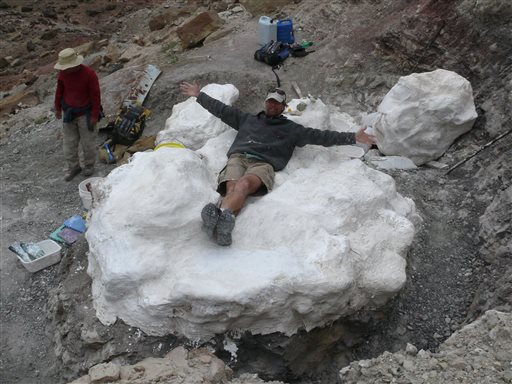How do you move a 5 ton dinosaur down a hill?
That’s the questions facing Utah paleontologists who are trying to bring a large collection of well-preserved fossils found north of Arches National Park back to their laboratory.
The scientists have been working to carve out a giant slab of fossils of Utahraptors and iguanodots and other dinosaurs for 10 years and would like to bring the pile back to a lab so it can be carefully studied.
That’s easier said than done, though. The fossils are in three, gigantic pieces on steep slope just below a cliff. To extract it properly would take a sky crane helicopter from out-of-state which would cost $100,000-plus, said state paleontologist James Kirkland said. That’s more than the annual budget for Kirkland and his staff.
Two of the blocks weigh about 1 ton each. The largest may weight up to 5 tons.
On Saturday, June 15, Kirkland and his crew brought down one of the smaller blocks that was estimated to weigh around 1 ton. They used the a bullet-hole ridden truck hood as a skid pulled by a Toyota truck to bring it down a very steep recently constructed road.
A Utah construction company is also offering to build a large, protective box to slowly drag the fossils down the slope. But that’s risky because it could flex, breaking the well-preserved fossils, Kirkland said.
“It’s really a tricky,” Kirkland said. “It is a logistic nightmare.”
With at least one dozen well-preserved dinosaur skeletons inside, Kirkland considers the massive slab of fossils encased in mudstone to be among the most important pieces he’s seen in his 40-year career. He and his team have already pulled out eight jaws of baby and adult Utahraptors.
Kirkland believes several big plant eaters, likely iguanodots, got stuck in the quicksand. Their cries or stinking carcasses probably attracted the meat-eating Utahraptors, who also got stuck in the quicksand and died.
“It was a feeding frenzy,” Kirkland said. “It turned into a predator death trap. It is full to the gunnel with Utahraptors, babies to adults, packed so tight you can’t get an ice pick into it.”
The mud killed them and buried them.
“That’s why things are so well preserved,” Kirkland said. “The preservation is gorgeous. All the teeth are in place.”
Kirkland says the group is hoping donations may come in to help pay to fly the fossils out. The Utahraptors closely resemble the raptors from the movie, Jurassic Park, he said.
“It’s turned into such an important thing. We need to get it off the hill,” Kirkland said. “I don’t want to leave this up there for five years because too much damage would happen.”
The fossils are found in the Yellow Cat member of the Cedar Mountain Formation, from the Jurassic geologic time period, approximately 145 to 200 million years ago.
Kirkland said that he and other paleontologists were taught that there were no dinosaur fossils to be found in the formation and so no one looked.
“That kept the riffraff out for decades,” Kirkland said.
As he has explored the formation he has discovered dinosaurs that had never been seen before, including the Utahraptor and the yet-to-be-officially-named sauropod that he calls the Moabsaurus.




